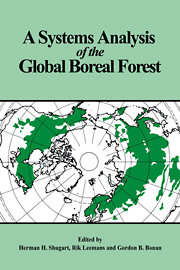Book contents
- Frontmatter
- Contents
- List of contributors
- 1 Introduction
- Part 1 Processes in boreal forests
- Introduction
- 2 Silvics of the circumpolar boreal forest tree species
- 3 The reproductive process in boreal forest trees
- 4 Soil temperature as an ecological factor in boreal forests
- 5 Fire as a controlling process in the North American boreal forest
- 6 The role of forest insects in structuring the boreal landscape
- Part 2 Patterns in space and time in boreal forests
- Part 3 Computer models for synthesis of pattern and process in the boreal forest
- References
- Index
6 - The role of forest insects in structuring the boreal landscape
Published online by Cambridge University Press: 12 January 2010
- Frontmatter
- Contents
- List of contributors
- 1 Introduction
- Part 1 Processes in boreal forests
- Introduction
- 2 Silvics of the circumpolar boreal forest tree species
- 3 The reproductive process in boreal forest trees
- 4 Soil temperature as an ecological factor in boreal forests
- 5 Fire as a controlling process in the North American boreal forest
- 6 The role of forest insects in structuring the boreal landscape
- Part 2 Patterns in space and time in boreal forests
- Part 3 Computer models for synthesis of pattern and process in the boreal forest
- References
- Index
Summary
Introduction
Human activities are increasingly affecting the relation between the biota and the physical environment. That has long been true of resource developments that have transformed vegetation on a regional scale. Now, however, the scale of human influence has increased to a planetary one because of the modification of the atmosphere by the accumulation of greenhouse gases and industrial pollutants (Clark & Munn 1986). The result could well be a significant increase in global temperature, as most general circulation models predict, exaggerated in the northern regions now occupied by the boreal forest. But our state of knowledge of such global-scale processes is sufficiently incomplete that the magnitude and location of those changes are highly uncertain. How, then, can we assess the impacts on vegetation, when we are so uncertain of the changes that might occur to the physical environment of northern regions? One way is to turn to the past to gain insight.
Certainly geophysical processes have led to planetary changes in the past that were extreme enough to trigger profound shifts in climate and in vegetation. When those produced pronounced shifts between glacial and interglacial conditions, the vegetation was transformed and individual species interactions became uncoupled to form a variety of transient assemblages very different from either those that preceded the shift (Wright 1987) or those that now characterize major biomes (Davis 1981).
Even modest changes in climate can be amplified if the frequency and extent of disturbance of vegetation is changed.
- Type
- Chapter
- Information
- A Systems Analysis of the Global Boreal Forest , pp. 170 - 191Publisher: Cambridge University PressPrint publication year: 1992
- 21
- Cited by



